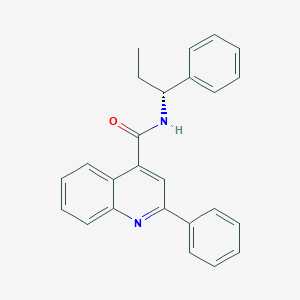

You can:
| Name | CHEMBL10079 |
|---|---|
| Molecular formula | C25H22N2O |
| IUPAC name | 2-phenyl-N-[(1R)-1-phenylpropyl]quinoline-4-carboxamide |
| Molecular weight | 366.464 |
| Hydrogen bond acceptor | 2 |
| Hydrogen bond donor | 1 |
| XlogP | 5.6 |
| Synonyms | 2-phenyl-N-[(1R)-1-phenylpropyl]quinoline-4-carboxamide SCHEMBL6447531 AC1LWX4B 2-Phenyl-quinoline-4-carboxylic acid ((R)-1-phenyl-propyl)-amide ZINC2105298 [ Show all ] |
| Inchi Key | MXNGYQJJYRVGGJ-JOCHJYFZSA-N |
| Inchi ID | InChI=1S/C25H22N2O/c1-2-22(18-11-5-3-6-12-18)27-25(28)21-17-24(19-13-7-4-8-14-19)26-23-16-10-9-15-20(21)23/h3-17,22H,2H2,1H3,(H,27,28)/t22-/m1/s1 |
| PubChem CID | 1760287 |
| ChEMBL | CHEMBL10079 |
| IUPHAR | N/A |
| BindingDB | 50074773 |
| DrugBank | N/A |
Structure |  |
| Lipinski's druglikeness | This ligand has a partition coefficient log P greater than 5. |
You can:
| GLASS ID | Name | UniProt | Gene | Species | Length |
|---|---|---|---|---|---|
| 216649 | Neuromedin-K receptor | P29371 | TACR3 | Homo sapiens (Human) | 465 |
| 216652 | Neuromedin-K receptor | P16177 | Tacr3 | Rattus norvegicus (Rat) | 452 |
| 216650 | Substance-K receptor | P21452 | TACR2 | Homo sapiens (Human) | 398 |
| 216651 | Substance-P receptor | P25103 | TACR1 | Homo sapiens (Human) | 407 |
zhanglab![]() zhanggroup.org | +65-6601-1241 | Computing 1, 13 Computing Drive, Singapore 117417
zhanggroup.org | +65-6601-1241 | Computing 1, 13 Computing Drive, Singapore 117417